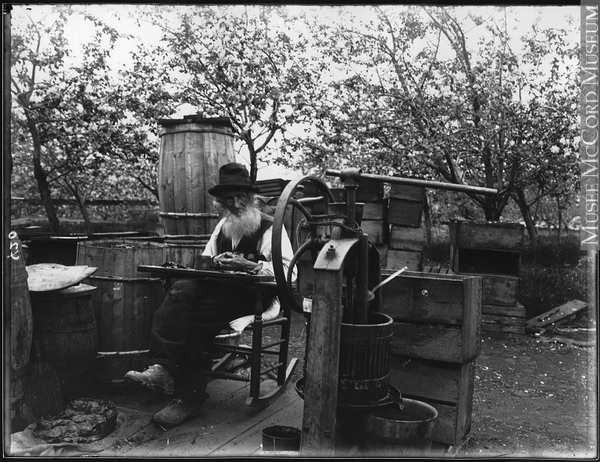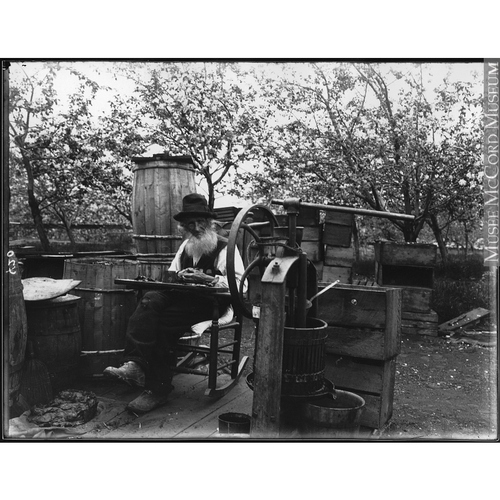
Source: Link
SHARP (Sharpe), FRANCIS PEABODY, orchardist, pomologist, and businessman; b. 3 Sept. 1823 in Northampton, N.B., son of Adam Boyle Sharp and Maria Peabody; m. 31 Dec. 1853 Maria Shaw of Lower Wakefield, N.B., and they had eight children, four of whom predeceased him; d. 12 Dec. 1903 in Woodstock, N.B.
Francis Peabody Sharp was named after his paternal grandfather, Captain Francis Alexander Sharp, who had served with the British garrison at Quebec, and his maternal great-grandfather, Captain Francis Peabody, a veteran of the Massachusetts forces in the Seven Years’ War and founder of Maugerville on the Saint John River. He may also have been named after his great-uncle Francis Peabody*, the founder of Chatham, N.B. His father was a lumberman, merchant, and magistrate.
Educated at Carleton County grammar school, Sharp became interested in the cultivation and propagation of fruit-trees while employed as a clerk and bookkeeper in his father’s store at Woodstock and began a serious tree-nursery business in 1846. His industry, singleness of purpose, and practical experimental techniques are clearly indicated in his minute hand-bound diary of the period 1846 to 1850. He grafted trees with scions obtained from England and from local growers in New Brunswick and Maine; he budded apple suckers, raised trees from seed, and made root grafts; and he recorded the distribution of his stock in numbered rows and plots.
Sharp cultivated many known varieties of apples, plums, and other fruits and vegetables but is remembered particularly as a pioneer of new apple varieties and hybrids. His most famous variety, derived by grafting scions from a seedling originating in Maine, was the New Brunswick or New Brunswicker. Its success was assured when, in competition with apples from all the eastern United States, it took first prize for the best barrel of any variety. In an attempt to produce new strains Sharp carried out about 2,000 hybridizing experiments using the New Brunswick variety as one of the parents.
Before 1850 few apples were grown in New Brunswick. In 1890 18,000 barrels were exported from Carleton County by the Sharp family alone. Six to seven carloads a year were shipped to Boston, Portland, and New York, and wholesale buyers from other parts of Canada came to Woodstock to buy direct. The American trade was, however, hit by the McKinley tariff of 1890.
The productivity of Sharp’s orchards led to the establishment in the region of allied industries such as barrel-making, canning, and packing. In his own business nothing went to waste. His eldest daughter, Minnie Bell*, described the production of vinegar with a huge press, designed by Sharp, working day and night: “A crew of ten to twenty men with apple grinders and all necessary outfit were kept busily employed.”
Sharp was conversant with scientific writings of the day and communicated with specialists in Ottawa and at the Iowa Agricultural College but was critical of the fruit-growing methods they advocated. His cultural practices were a testament to his acumen for he discovered that he could obtain the optimum return per acre by careful cultivation, heavy manuring, and close planting of dwarf trees, and by keeping a careful balance between the roots and the top growth of trees. Keen to share his knowledge but mindful of the needs of his family, he wrote to Minnie Bell of a paper he gave to the Farmers’ and Dairymen’s Association of New Brunswick in 1896: “You will see that it is remarkable for what is left out. . . . Many of my discoveries would so greatly cheapen production of apples as to injure our own sales.”
A genial conversationalist, a lover of music and books, and generous to a fault, Sharp appears to have lacked a number of qualities essential to success in business. For many years he worked in partnership with his brother-in-law William Sperry Shea, who provided capital and, probably, management skills. After Shea’s death in 1876, Sharp’s eldest son, Franklin, became a key figure, and Francis made over the nursery at Woodstock to him in 1887. In 1892 they suffered a disastrous fire; Franklin died the same year and the property went to his younger sisters.
Sharp had a close emotional tie to his daughter Minnie Bell, an accomplished musician and organizer, and her equally remarkable husband, the artist, naturalist, and ethnologist Edwin Tappan Adney*. In his last years he worked with them in trying to restore his personal fortunes.
There is an oil portrait of Francis Peabody Sharp, painted by Edwin Tappan Adney, in the Old Arts Building at the Univ. of N.B., Fredericton.
Sharp’s papers, including his diary for 1846–50, a typescript copy of it, and his correspondence with Minnie Bell and others, are preserved among the E. T. Adney papers at the N.B. Museum. The collection also contains material on apple cultivation, Adney’s biographical notes on Sharp, and documents and clippings relating to the family. Some of this material is also available on microfilm at PANB, RS184, A, Adney file.
PANB, RS62, 1876, W. S. Shea; 1892, Franklin Sharp. Carleton Sentinel (Woodstock, N.B.), 18 Dec. 1903: 8. Dispatch (Woodstock), 16 Dec. 1903: 1, 4. David Folster, “Apple blossom time and the man who made Eden,” Daily Gleaner, 23 May 1984: 16. Press (Woodstock), 4 Jan. 1904: 4. M. B. [Sharp] Adney, “Minnie Bell Adney, an autobiography,” Carleton Sentinel, 10 Oct. 1919: 1, 8. Bill Turney, “Adney game management area set up near Woodstock,” Daily Gleaner, 20 March 1965 (clipping in N.B. Museum, E. T. Adney papers). E. B. DeMerchant, From humble beginnings: the story of agriculture in New Brunswick (Fredericton, 1983 [i.e., 1984]), 43–44.
Cite This Article
C. Mary Young, “SHARP (Sharpe), FRANCIS PEABODY,” in Dictionary of Canadian Biography, vol. 13, University of Toronto/Université Laval, 2003–, accessed December 31, 2025, https://www.biographi.ca/en/bio/sharp_francis_peabody_13E.html.
The citation above shows the format for footnotes and endnotes according to the Chicago manual of style (16th edition). Information to be used in other citation formats:
| Permalink: | https://www.biographi.ca/en/bio/sharp_francis_peabody_13E.html |
| Author of Article: | C. Mary Young |
| Title of Article: | SHARP (Sharpe), FRANCIS PEABODY |
| Publication Name: | Dictionary of Canadian Biography, vol. 13 |
| Publisher: | University of Toronto/Université Laval |
| Year of publication: | 1994 |
| Year of revision: | 1994 |
| Access Date: | December 31, 2025 |



